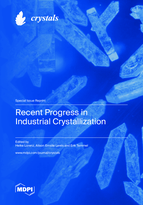Recent Progress in Industrial Crystallization
A special issue of Crystals (ISSN 2073-4352). This special issue belongs to the section "Industrial Crystallization".
Deadline for manuscript submissions: closed (30 June 2022) | Viewed by 32235
Special Issue Editors
Interests: phase equilibria; crystallization kinetics; process monitoring & design; separation of fine chemicals, large scale industrial products and renewable resources; innovative crystallization-based separation concepts; enantiomers; natural products; multi-component mixtures
Special Issues, Collections and Topics in MDPI journals
Interests: industrial crystallization; freeze crystallization; water treatment
Interests: melt crystallization; crystallizer design; fractional crystallization; phase equilibria; crystallization kinetics; continuous crystallization; process monitoring; process design; applied population balance and process modelling; process intensification and combination; process optimization; novel measurement techniques
Special Issue Information
Crystallization is an important industrial process, a purification technique, a separation process and a branch of particle technology. It also encompasses several key areas of chemical and process engineering. Industrial crystalline products include bulk chemicals, such as sodium chloride and sucrose, fertilizer chemicals such as potassium chloride and urea and, high-price products such as pharmaceuticals, platinum group metal salts, high-grade materials for battery production and organic fine chemicals such as food additives. Industrial crystallization further plays a role in the new and rapidly expanding field of engineered nanoparticles and the production of crystals for the electronics industry and biotechnology. Other prominent industrial application domains comprise the use of crystallization in water and effluent treatment, reflecting the waste-to-resource movement that is becoming increasingly important and relevant in the field.
The overall theme of this Special Issue is how theoretical concepts are adapted in industrial crystallization, and how practical understanding in the field is enhanced through applied research. The latter covers a wide range of subjects, such as crystallization fundamentals, analytical tools for process analysis and monitoring, crystallization process and product design, as well as the integration of crystallization in industrial process chains for, for example, solving environmental and sustainability issues. These topics are also the focus of the 21st International Symposium on Industrial Crystallization (ISIC 21) held from 31 August to 2 September this year (https://dechema.de/en/ISIC_2021), seen as the most important international conference in the field.
This Special Issue is dedicated to Professor Gerda van Rosmalen (27 May 1936–18 January 2021), who was a pioneer in this field. She developed the field of industrial crystallization research through her original courses developed over many decades and given to industrial partners and postgraduate students. Professor van Rosmalen spent 20 years as the Professor of Industrial Crystallization and Clean Technology at the Laboratory for Process Equipment at TU Delft in the Netherlands, and her distinguished positions include being a Board Member of the Working Party on the Industrial Crystallization of the European Federation of Chemical Engineers. She was regarded globally as a pre-eminent figure in industrial crystallization.
The keywords given below encompass examples addressed in the Special Issue, but papers concerning other innovative and novel subjects in industrial crystallization are also welcome.
Prof. Dr. Heike Lorenz
Prof. Dr. Alison Emslie Lewis
Dr. Erik Temmel
Guest Editors
Manuscript Submission Information
Manuscripts should be submitted online at www.mdpi.com by registering and logging in to this website. Once you are registered, click here to go to the submission form. Manuscripts can be submitted until the deadline. All submissions that pass pre-check are peer-reviewed. Accepted papers will be published continuously in the journal (as soon as accepted) and will be listed together on the special issue website. Research articles, review articles as well as short communications are invited. For planned papers, a title and short abstract (about 100 words) can be sent to the Editorial Office for announcement on this website.
Submitted manuscripts should not have been published previously, nor be under consideration for publication elsewhere (except conference proceedings papers). All manuscripts are thoroughly refereed through a single-blind peer-review process. A guide for authors and other relevant information for submission of manuscripts is available on the Instructions for Authors page. Crystals is an international peer-reviewed open access monthly journal published by MDPI.
Please visit the Instructions for Authors page before submitting a manuscript. The Article Processing Charge (APC) for publication in this open access journal is 2600 CHF (Swiss Francs). Submitted papers should be well formatted and use good English. Authors may use MDPI's English editing service prior to publication or during author revisions.
Keywords
- Nucleation
- Crystal growth
- Polymorphism, solvates, co-crystals and solid solutions
- Crystallization
- Precipitation
- Monitoring of crystallization
- Crystallization hybrid processes
- Application in large-scale, fine chemical, specialty and life science industries
- Sustainability: circular economy, resource recovery
Related Special Issue
- Advances in Industrial Crystallization in Crystals (16 articles)








